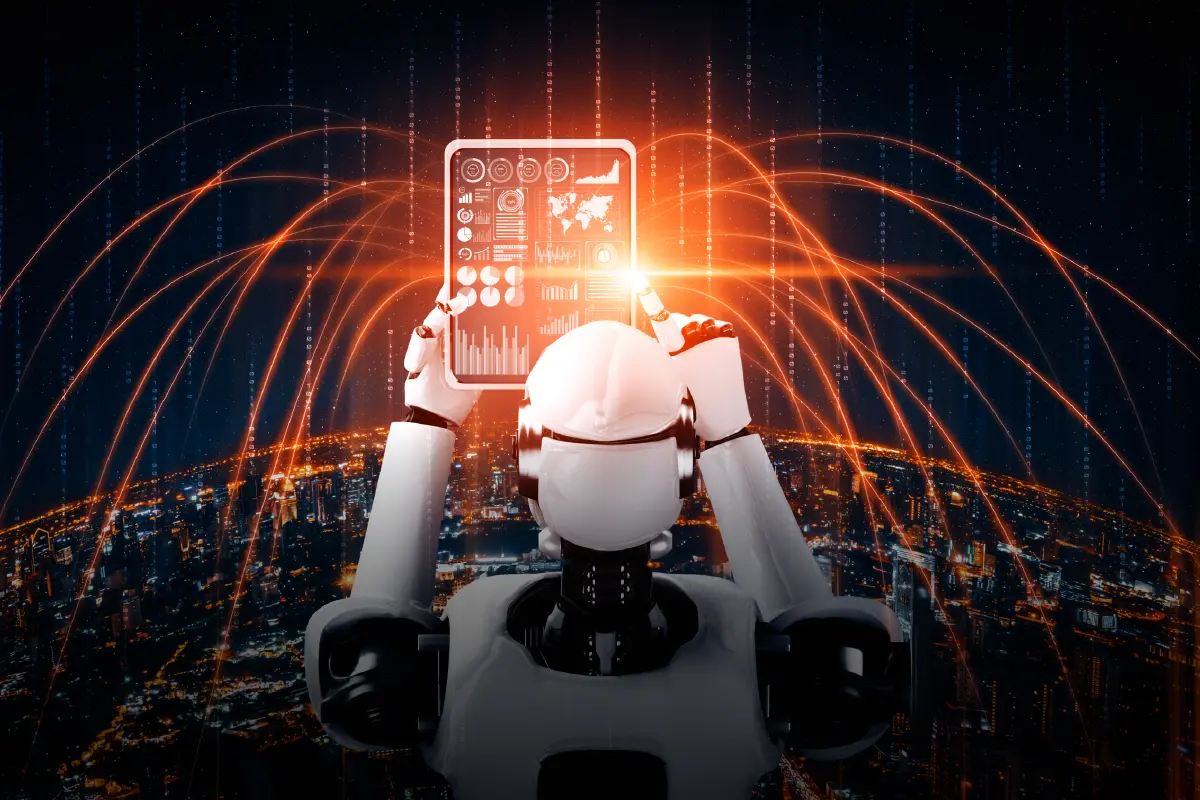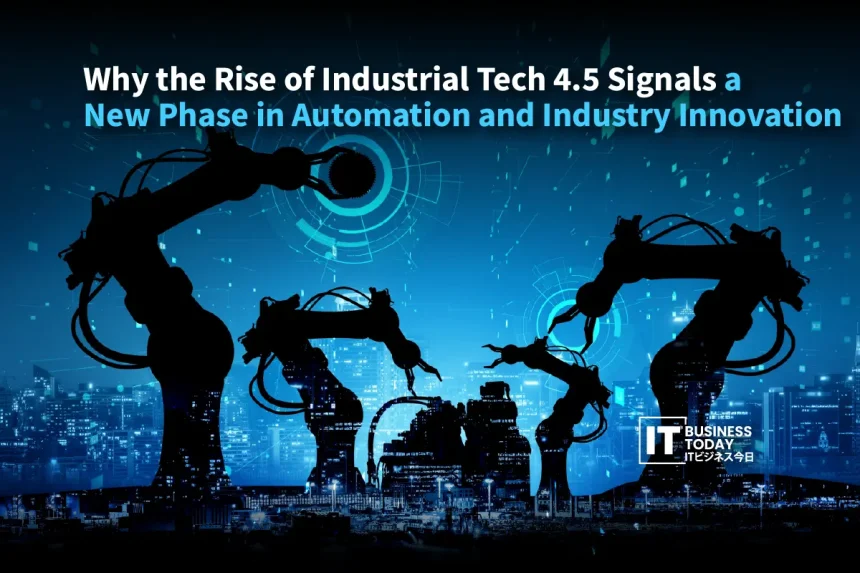Industry 4.0 looked huge when it arrived. Companies connected machines, pushed everything to the cloud, and bragged about Big Data dashboards that promised efficiency. It worked to an extent. You got visibility. You got faster reporting. But the factory still waited on humans to interpret the data and make the next move. The gap between insight and action never fully closed.
Industrial Tech 4.5 changes that story. This is not a small upgrade. This is the moment the system starts thinking at the speed the shop floor actually demands. Instead of stopping at connectivity, 4.5 pushes into autonomy and self-optimization. Machines talk to each other. They correct themselves. They run scenarios before anyone even knows something is drifting.
The fuel behind this shift is the fusion of Edge AI, Generative AI, and high-fidelity Digital Twins. Edge AI handles real-time judgment. GenAI accelerates design and decision cycles. Digital Twins mirror every operation so the plant can model outcomes without touching physical equipment.
Also Read: Solving Japan’s Talent Crunch: How HR Tech Is Enabling Retention in an Ageing Workforce
Fusing all these factors leads to a time that transforms competitiveness. Industrial Tech 4.5 turns into the support of endurance, eco-friendliness, and a more intelligent alliance of people and machines. From here, the next generation of victors will emerge.
The Core Technological Pillars of Industrial Tech 4.5
Industrial Tech 4.5 sounds fancy on paper but the real shift is happening down on the factory floor where latency is not just a tech term but a very real pain point.
When a machine needs to react in a split second, the cloud often feels like sending a message to someone in another city and hoping they reply on time. That delay might work for watching videos but not for a production line running at full tilt. This is where Edge AI steps in. It sits close to the machines and reads vibration, thermal and acoustic signals right on the spot.
As a result, it cuts out the waiting and keeps everything moving. No surprise that 65 percent of organizations are already running an IIoT strategy and many see a break even in roughly twenty months which tells you companies are not just experimenting anymore; they are doubling down.
As you move deeper into 4.5 you see digital twins growing up fast. They are no longer static models collecting dust. They behave more like living systems that pull in real time data from Edge AI and adjust themselves as the physical environment changes.
So instead of guessing how a system will behave, teams can run stress tests, tweak configurations and preview changes before touching a real machine. And this trend is not small.
Samsung and Nvidia teaming up to build an AI Factory with 50,000 GPUs shows how quickly simulation and physical AI are scaling. This scale signals a new era where industry stops reacting and starts predicting which is pretty much the heart of Industrial Tech 4.5.
Generative AI Rising as the New R&D and Design Engine

Generative AI has shifted from being a smart analysis tool to becoming the real engine behind industrial innovation. In the Industrial Tech 4.5 world, the point is not just spotting problems or tweaking processes. GenAI now creates. It generates millions of design variations inside the constraints you set. You can aim to lighten a component, sharpen fluid dynamics, or combine materials in ways your R and D team would never consider. It explores design spaces that humans simply do not have the time or bandwidth to cover, while still following engineering logic and physics.
The impact runs deeper than design. GenAI is unlocking cognitive automation across the production floor. Traditional automation focused on predictable, repetitive tasks like a robot hitting the same weld point. Cognitive automation reacts. It reads thermal sensors, vibration data, supply chain signals, and outside conditions. Then it adjusts the production schedule or shifts quality control tolerances in real time. This turns AI into a workmate. A system that does not just follow instructions but thinks along with your experts.
And companies are already seeing the payoff. More than 70 percent of organizations report actual return on investment from generative AI. Not pilots. Not experiments. Real ROI. For human workers, this is an upgrade, not a threat. They get an AI co-pilot that filters noise, surfaces the most important insights, and points to the smartest actions. The outcome is faster innovation, sharper decisions, and a new rhythm between humans and machines that drives Industrial Tech 4.5 forward.
Driving the ‘Triple Bottom Line’ with 4.5
Industrial Tech 4.5 is quietly becoming the grown up in the room. Companies are finally moving past the hype stage and chasing outcomes that hit money, people, and planet in one shot. IBM is a good example of what happens when you stop talking and start wiring these systems into real workflows. They have already unlocked USD 4.5 billion in productivity gains since January 2023. That is not a cute slide. That is actual financial gravity pulling the entire industry forward.
3.1 Resilience through Prescriptive Maintenance
Most factories are still stuck in the predictive stage where the system tells you something might fail. The 4.5 shift is far more direct. You get to know why it will fail and exactly what parts, people, and steps you need to prevent it. This cuts out the panic repairs and the expensive downtime that usually pops up at the worst possible time. It also pushes teams into a calm and repeatable rhythm where decisions are grounded in real data, not guesswork.
3.2 Human Centricity and Safety
The fun twist here is that 4.5 actually gives workers more control. Real-time instructions, safety alerts, and training prompts are directly projected into their vision by AR and VR overlays. When combined with live Digital Twin data, it no longer feels like a manual, instead, it is like a co-pilot that will not allow you to miss anything important. Cobots further contribute by taking over precision tasks while humans concentrate on decision-making and supervision. The entire atmosphere is transformed into a safer, smoother, and significantly less stressful one.
3.3 The Sustainability Mandate
Energy, emissions, waste. These are no longer side issues. AI now tunes energy use in real time and Digital Twins help teams test different production scenarios before they touch the actual line. You see the carbon impact upfront, not after the damage is done. It makes sustainability measurable and practical instead of a checkbox exercise.
Navigating Challenges and The Implementation Roadmap
Industrial Tech 4.5 sounds futuristic on paper, but the real world is messier. Teams run into walls before they see any of the fancy gains everyone keeps talking about. The good part is that most of these challenges are predictable, so the roadmap is more about discipline than luck.
The first sticking point is data. You have information moving across Edge devices, private networks, and cloud platforms. Each layer opens a new door for risk. Zero trust security is not a nice to have anymore. It is the only sane way to secure distributed systems. You also need clean data lineage so teams can trace where every tiny data point came from and how it has been used.
Then comes the human gap. You need people who understand OT, IT, and AI all at once. Those engineers are rare. Companies are now forced to build internal upskilling paths that teach workers how to apply machine learning inside industrial environments. If not, the tech stays shelf ware.
The last hurdle is integration. Old equipment refuses to play nicely with new IIoT protocols. Retrofitting is expensive and slow. No surprise that only 5% of warehouses are using sophisticated automation gear. The roadmap here is phased modernization rather than ripping everything out in one go.
The Future of Autonomous Industry

Industrial Tech 4.5 is not another buzz cycle. It is the point where the digital factory finally grows up. Instead of just connecting machines and streaming data, the system starts thinking for itself. GenAI takes on design and decision work that used to choke teams. Digital Twins mirror every process in real time so the factory can predict, adapt, and act without waiting for someone to click a button. This is the shift from digital to truly autonomous operations.
The direction is obvious. Lacking these abilities, your challenge will be likened to a race with leg weights. Businesses that deeply involve themselves in 4.5 technology will get the benefits of cumulative efficiency, the luxury of being able to adapt that protects them from disturbances, and the environmental friendliness that is already demanded by governments and markets. The age of small pilot experiments is done. The next winners are the ones who scale 4.5 across the entire enterprise and move fast.







